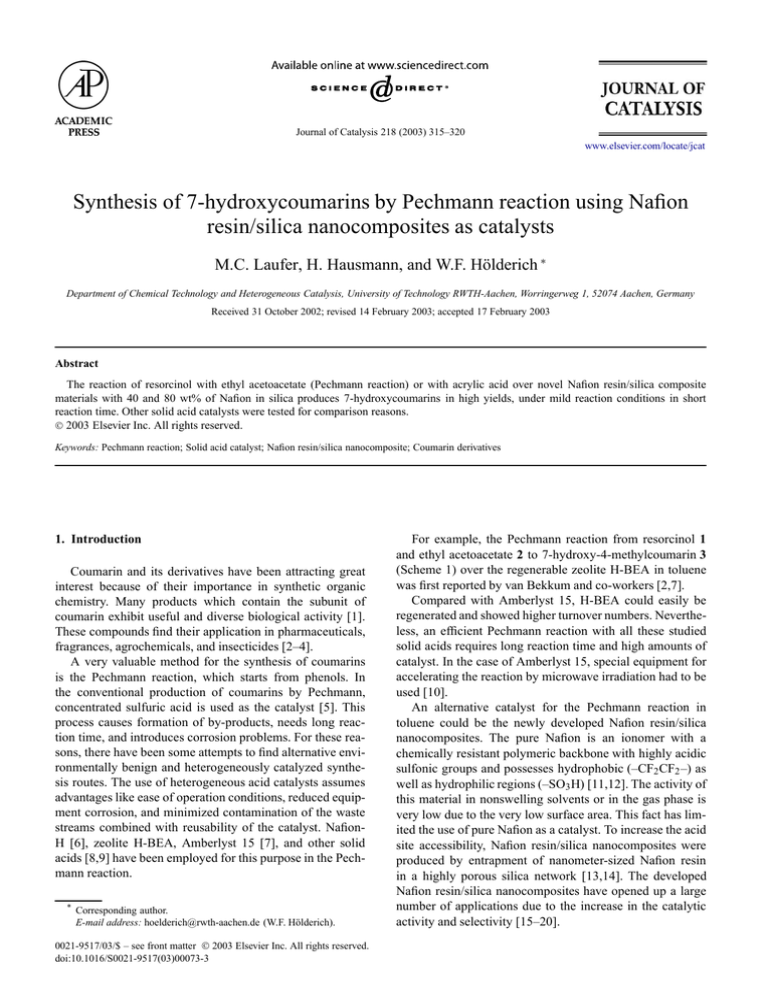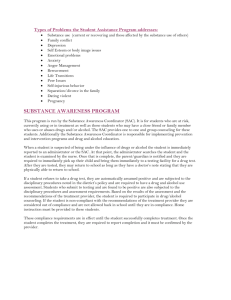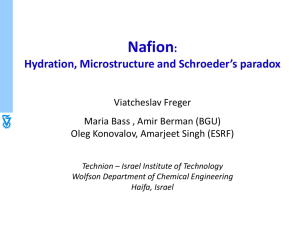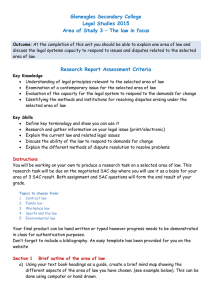
Journal of Catalysis 218 (2003) 315–320
www.elsevier.com/locate/jcat
Synthesis of 7-hydroxycoumarins by Pechmann reaction using Nafion
resin/silica nanocomposites as catalysts
M.C. Laufer, H. Hausmann, and W.F. Hölderich ∗
Department of Chemical Technology and Heterogeneous Catalysis, University of Technology RWTH-Aachen, Worringerweg 1, 52074 Aachen, Germany
Received 31 October 2002; revised 14 February 2003; accepted 17 February 2003
Abstract
The reaction of resorcinol with ethyl acetoacetate (Pechmann reaction) or with acrylic acid over novel Nafion resin/silica composite
materials with 40 and 80 wt% of Nafion in silica produces 7-hydroxycoumarins in high yields, under mild reaction conditions in short
reaction time. Other solid acid catalysts were tested for comparison reasons.
2003 Elsevier Inc. All rights reserved.
Keywords: Pechmann reaction; Solid acid catalyst; Nafion resin/silica nanocomposite; Coumarin derivatives
1. Introduction
Coumarin and its derivatives have been attracting great
interest because of their importance in synthetic organic
chemistry. Many products which contain the subunit of
coumarin exhibit useful and diverse biological activity [1].
These compounds find their application in pharmaceuticals,
fragrances, agrochemicals, and insecticides [2–4].
A very valuable method for the synthesis of coumarins
is the Pechmann reaction, which starts from phenols. In
the conventional production of coumarins by Pechmann,
concentrated sulfuric acid is used as the catalyst [5]. This
process causes formation of by-products, needs long reaction time, and introduces corrosion problems. For these reasons, there have been some attempts to find alternative environmentally benign and heterogeneously catalyzed synthesis routes. The use of heterogeneous acid catalysts assumes
advantages like ease of operation conditions, reduced equipment corrosion, and minimized contamination of the waste
streams combined with reusability of the catalyst. NafionH [6], zeolite H-BEA, Amberlyst 15 [7], and other solid
acids [8,9] have been employed for this purpose in the Pechmann reaction.
* Corresponding author.
E-mail address: hoelderich@rwth-aachen.de (W.F. Hölderich).
0021-9517/03/$ – see front matter 2003 Elsevier Inc. All rights reserved.
doi:10.1016/S0021-9517(03)00073-3
For example, the Pechmann reaction from resorcinol 1
and ethyl acetoacetate 2 to 7-hydroxy-4-methylcoumarin 3
(Scheme 1) over the regenerable zeolite H-BEA in toluene
was first reported by van Bekkum and co-workers [2,7].
Compared with Amberlyst 15, H-BEA could easily be
regenerated and showed higher turnover numbers. Nevertheless, an efficient Pechmann reaction with all these studied
solid acids requires long reaction time and high amounts of
catalyst. In the case of Amberlyst 15, special equipment for
accelerating the reaction by microwave irradiation had to be
used [10].
An alternative catalyst for the Pechmann reaction in
toluene could be the newly developed Nafion resin/silica
nanocomposites. The pure Nafion is an ionomer with a
chemically resistant polymeric backbone with highly acidic
sulfonic groups and possesses hydrophobic (–CF2 CF2 –) as
well as hydrophilic regions (–SO3 H) [11,12]. The activity of
this material in nonswelling solvents or in the gas phase is
very low due to the very low surface area. This fact has limited the use of pure Nafion as a catalyst. To increase the acid
site accessibility, Nafion resin/silica nanocomposites were
produced by entrapment of nanometer-sized Nafion resin
in a highly porous silica network [13,14]. The developed
Nafion resin/silica nanocomposites have opened up a large
number of applications due to the increase in the catalytic
activity and selectivity [15–20].
316
M.C. Laufer et al. / Journal of Catalysis 218 (2003) 315–320
Scheme 1. Reaction of resorcinol and ethyl acetoacetate.
2. Experimental
2.1. Catalysts and analytical methods
The pure Nafion resin NR 50 and the composite materials were kindly provided by DuPont de Nemours & Company, Wilmington. The Nafion resin/silica composites contain 13% (SAC 13), 40% (SAC 40), and 80% (SAC 80)
Nafion on silica, respectively. Amberlyst 15 was purchased
from Fluka. Before use, all resins were dried at 120–150 ◦ C
in vacuum for 4 h.
The zeolites used in this work are commercially available from Zeolyst International: H-Y(US), Na-BEA, and HZSM-5. The concentrations of Si and Al in the samples were
determined by inductively coupled plasma atomic emission
spectroscopy (ICP-AES) (Spectroflame D, Spectro Analytic
Instrument). The number of acid sites of the catalysts was
determined by ionexchange of the protons with a fivefold
excess of CuSO4 and ZnSO4 solutions at 80 ◦ C for 24 h. After washing with distilled water, the samples were dried at
120–150 ◦ C in vacuum for 4 h. Then, the concentrations of
Cu(II) and Zn(II) were measured by ICP-AES.
Na-BEA was converted to the acid form by a double
ionexchange with a tenfold excess of 2 N NH4 NO3 (aqueous) at 80 ◦ C and all the zeolites have been calcined at
550 ◦ C for 8 h before use.
The solid state 13 C NMR spectra were recorded on a
Bruker DSX 500 spectrometer equipped with a wide-bore
super-conducting magnet operating fieldstrength of 11.744 T
and a resonance frequency for 13 C nuclei of 125.85 MHz.
All spectra were recorded with a 7-mm multinuclear (50–
161 MHz) double-bearing CP/MAS probehead at room temperature. Magic angle spinning (MAS) with a rotational
speed of 5 kHz was applied for all spectra and controlled
with a MAS-Remote-Control-Unit (Type H 2620, stability
±2 Hz). The 13 C NMR spectra were referred to external
TMS. For the NMR measurements, 7-mm ZrO2 rotors were
filled with 200–300 mg of the compounds and tightly locked
with Kel-F caps.
The materials were also analysed with nitrogen sorption at −196 ◦ C (Micromeritics ASAP 2010) using the BET
method to determine the surface area. Prior to the measurements, the samples were degassed at 100 ◦ C and high vacuum.
All chromatographic measurements were performed on
a HP 6890 gas chromatograph equipped with a flame ionisation detector and using a FS-SE54 capillary column
(50 m × 0.25 µm) operated between 50 and 270 ◦ C with
a ramp of 12 ◦ C min−1 . Nitrogen was used as the carrier
gas. The detector temperature was at 300 ◦ C and a 1-µl volume sample was injected. Identification of the compounds
by GC-MS was performed on Varian Satum 3 equipment.
2.2. Reaction procedure
The reactions were carried out in batch reactors, partially
under argon. Typically, 10 mmol of each reactant and 0.5 g
of catalyst were stirred in 10 ml of toluene under reflux for
2 h. Subsequently, 10 ml of acetone were added to dissolve
all products. Liquid samples were taken out of the reactor
and analyzed by GC. Acetic acid phenyl ester was used as
the internal standard. For recycle experiments, the catalysts
were filtered off, washed with acetone, and then reused without further treatment.
2.3. Regeneration of the catalyst
Catalyst (0.5 g) was stirred in 20 ml of 15 wt% aqueous H2 O2 at 80 ◦ C for at least 2 h to recover its original
appearance. Then, the catalyst was filtered off, washed with
distilled water, and dried at 120–150 ◦ C in vacuum for 4 h.
3. Results and discussion
3.1. Synthesis of 7-hydroxy-4-methylcoumarin via the
Pechmann reaction
For the Pechmann reaction of resorcinol (1) and ethyl acetoacetate (2) to produce 7-hydroxy-4-methylcoumarin (3)
(Scheme 1) in toluene, Amberlyst 15 and zeolites were compared with the pure Nafion and with Nafion resin/silica
composites. Fig. 1 illustrates the performance of the different heterogeneous catalysts in the Pechmann reaction in
toluene. The reaction proceeds through transesterification
and intramolecular hydroxyalkylation, followed by dehydration [2,7].
7-Hydroxy-4-methylcoumarin was obtained in very high
yields up to 81% over SAC 40 (containing 40% Nafion on
silica) and 96% yield over the SAC 80 (80% of Nafion in
composite) in refluxing toluene after 2 h of contact time. In
contrast to the reaction conditions of the Pechmann reaction
in toluene studied by van Bekkum and co-workers [2,7], the
use of the Nafion resin/silica composite materials led to two
M.C. Laufer et al. / Journal of Catalysis 218 (2003) 315–320
317
Fig. 1. Synthesis of 7-hydroxy-4-methylcoumarin with different heterogeneous catalysts.
Fig. 2. Synthesis of 7-hydroxy-4-methylcoumarin with reused, nonregenerated SAC 80.
remarkable effects. First, the amount of catalyst was reduced
up to 50% and, second, the reaction time was divided in half.
The activity of the composites correlates with the amount
of Nafion on silica. Therefore, the conversion of resorcinol raises from 68% for 13 wt% Nafion containing material (SAC 13) to 83% for the 40 wt% containing composite
(SAC 40). The better activity of SAC 40 and SAC 80 compared with that of SAC 13 cannot be explained by higher
BET surface area or cumulative pore volume. N2 -sorption
data show that the BET surface area and the pore volume of
SAC 40 (71.40 m2 g−1 ; 17.48 × 10−2 cm3 g−1 ) and of SAC
80 (16.89 m2 g−1 ; 4.16 × 10−2 cm3 g−1 ) were lower than
those of SAC 13 (94.92 m2 g−1 ; 22.32 × 10−2 cm3 g−1 ).
Therefore, it can be concluded that the higher catalytic performance of SAC 40 and particularly of SAC 80 is due to the
higher amount of strong acid centers related to the increased
amount of Nafion on silica (Table 1).
However, in the case of the pure Nafion resin NR 50, the
surface area is too low (< 0.02 m2 g−1 ) [13] and seems to
influence negatively the accessibility to these acid centers.
As a result, despite its higher acidic capacity, the conversion of resorcinol by using the pure Nafion NR 50 reaches
only 78%.
In the case of Amberlyst 15, a conversion of resorcinol of
74% can be observed. Although the number of acid sites is
high (Table 1), it is generally accepted that Amberlyst 15 is
not such a strong acid like the perfluorinated sulfonic acid
resin [20]. The value of the Hammett acidity function (H0 )
ranges from −11 to −13 for Nafion compared to about −2.2
for Amberlyst 15.
In contrast to our newly founded better activity under
milder reaction conditions with reduced amount of catalyst,
the low conversion of resorcinol (36%) in the presence of
H-BEA {16} (in braces, the silica alumina ratios) are not
comparable with the better results of van Bekkum [2,7].
Furthermore, the activities of other zeolites like H-Y(US)
{40} or H-ZSM 5 {28} are remarkably low with conversions
of resorcinol of 10 and 3%, respectively. Probably, resorcinol is not able to optimally enter the pores of the zeolites.
Not only in the phenol alkylation with methanol to cresol
using H-Y, H-Y(US), or H-ZSM-5 but also in the hydroxylation of phenol with H-ZSM-5, the formation of ortho/para
products was favored [21]. In contrast, resorcinol is a meta
hydroxy substituted phenol and perhaps hindered from diffusing through the zeolitic channels.
As described in the literature [6–9], we also carried
out the Pechmann reaction preferably in toluene as solvent. Other aromatic solvents with higher boiling point like
cumene or the more toxic p-Cl-toluene did not improve the
obtained yield of the desired coumarin. Besides, with those
last mentioned solvents, rapid deactivation of the Nafion
resin/silica composites was observed. The use of nonaromatic solvents like tetrahydrofuran, petroleum ether, and
dichloromethane, which is connected with lower reaction
temperatures, did not show competitive results.
To investigate whether the catalyst could be recycled, the
most active Nafion resin composite SAC 80 was filtered off,
rinsed with acetone, and dried under ambient conditions for
2 h after each experiment. As presented in Fig. 2, there is
a decrease in the conversion of resorcinol from 98 to 91%
after the first recycle.
After a second reaction cycle, the conversion decreased
another 2%. In the following four reaction cycles, however, the conversion remained constant at ca. 89%. Nevertheless, the selectivity to 7-hydroxy-4-methylcoumarin did
not change; it remained constant at ca. 98% for all six
cycles. The deactivation of the catalyst is low, although
coke formation by aromatic resorcinol or coumarin was
expected [15–19]. Apart from a rapid and high conversion (> 98%) of resorcinol with the ethyl acetoacetate, the
formed coumarin precipitates in refluxing toluene in high selectivity (98%). Therefore, a strong adsorption/deposition of
Table 1
Acidic capacity of the catalysts
Catalyst
Capacity (mequiv of H+ /g)
SAC 13
0.08
SAC 40
0.25
SAC 80
0.43
NR 50
0.89
Amb. 15
4.30
H-BEA
0.49
H-Y(US)
0.14
H-ZSM-5
0.19
318
M.C. Laufer et al. / Journal of Catalysis 218 (2003) 315–320
Scheme 2. Reaction of resorcinol and acrylic acid.
Fig. 3. Synthesis of 7-hydroxy-3,4-dihydrocoumarin with different heterogeneous catalysts.
Fig. 4. Synthesis of 7-hydroxy-3,4-dihydrocoumarin with reused, nonregenerated SAC 80.
the solid product on the solid catalyst is more difficult. This
may probably explain the low deactivation of the catalyst.
For the complete reactivation of SAC 80, a washing procedure with diluted nitric acid [14] or hydrogen peroxide
solution can be applied. After this treatment, either with nitric acid or with hydrogen peroxide, the original activity of
the catalyst with 98% conversion of resorcinol can be restored. Due to the possibility to regenerate the catalyst and
the fact that the reaction did not continue after the catalyst
was removed, Nafion leaching in nonpolar toluene can be excluded. As reported in the literature, the Nafion resin/silica
composite materials produced by an in situ sol–gel technique
exhibit for several reaction types excellent lifetime stability [14]. The Nafion particles are well entrapped in the silica
network.
observable by GC-MS. Fig. 3 shows the results of the synthesis of 7-hydroxy-3,4-dihydrocoumarin from resorcinol
and acrylic acid with different heterogeneous catalysts in refluxing toluene.
Also in this reaction, SAC 40 and SAC 80 led to the
best results. After the short contact time of only 2 h, the
yield of the desired coumarin was enhanced from 78% up to
86% by increasing the amount of Nafion in silica from 13 to
40%, whereas with the pure Nafion NR 50 only 64% yield
was achieved. Since the number of the acid sites is lower,
Nafion/silica composites with 13 or 40% loading of Nafion
show increasing selectivity up to 95 and 94%, respectively.
On account of the high yield of 80% obtained, Amberlyst
15 is here more competitive with the Nafion/silica composites than the pure Nafion NR 50. H-BEA demonstrated a
high selectivity to 5 (88%) but still too low activity (59%).
As in the case of the Pechmann reaction to 7-hydroxy-4methylcoumarin, low activity of the acidic H-Y(US) or HZSM-5 zeolites could be confirmed.
In further experiments, the recycling of SAC 80 was examined. Fig. 4 describes the gradual decrease of the catalyst
activity until its complete loss after four cycles.
As presented in Fig. 3 and Table 1, a decreased number
of acid sites seems to be responsible for the observed increase in selectivity to 5. Furthermore, contamination of the
catalyst can also reduce the number of acid sites. Hence, the
3.2. Synthesis of 7-hydroxy-3,4-dihydrocoumarin
A modification of the Pechmann reaction involves the use
of an α, β-unsaturated carboxylic acid instead of β-ketoesters. The reaction of resorcinol (1) with acrylic acid (4) to
7-hydroxy-3,4-dihydrocoumarin (5) (Scheme 2) was found
to involve esterification followed by ring closure.
As emphasized in the literature [7], ring closure is faster
than the Fries rearrangement. The formation of the consecutive product [1,2-b:5,4-b]dipyran-2,8-dione (6) [7] is also
M.C. Laufer et al. / Journal of Catalysis 218 (2003) 315–320
formation of the consecutive product 6 decreases with the
deactivation grade of the catalyst. Experiments with SAC
80 in diluted reaction mixtures did not lead to substantial
improvement of selectivity to 5 and to reduced coke formation on the catalyst. For example, the use of a twofold
or threefold amount of toluene improves the selectivity to 5
around 2%.
It has to be pointed out that the formation of the side product 6 affords only 1 equiv of resorcinol and 2 equiv of acrylic
acid. If the by-product 6 is formed, unchanged resorcinol
is expected in the reaction mixture. Nevertheless, resorcinol
could not be detected in the reaction solution. Therefore, it
might be that the unchanged resorcinol is adsorbed on the
SAC 80 and might be responsible for coke formation on the
catalyst.
The easy adsorption of resorcinol can be demonstrated
by stirring the catalyst separately with each reactant, resorcinol as well as acrylic acid, under the reaction conditions
in toluene. In the case of resorcinol, the catalysts becomes
rapidly dark. 13 C MAS NMR measurements with treated
SAC 80 explained the supposed strong adsorption of resorcinol (Fig. 5). The 13 C NMR measurements were carried out
after washing the catalyst several times with acetone.
319
With the adsorption on SAC 80, the symmetry of resorcinol is lost. In the spectrum of the adsorbed resorcinol, more
signals for the nonequivalent positions can be observed.
The signals at 106.6 and 154.3 ppm (spectra A) are characteristic for symmetric carbons of the original resorcinol.
On the other hand, four signals at 110.4, 118.2, 151.9, and
164.7 ppm in the spectra of treated catalyst (spectra B) are
observable. The peak at 29.3 ppm can be assigned to toluene.
Treatment with acrylic acid did not result in catalyst deactivation. By 13 C MAS NMR, it was not possible to detect
any acrylic acid on the catalyst after washing with acetone.
After treatment in acrylic acid solution, the colorless SAC
80 showed its maximal performance when it was used again
in the synthesis of 7-hydroxy-3,4-dihydrocoumarin 5. In this
way, it could be concluded that resorcinol but not acrylic acid
adsorption constitutes the main cause for catalyst deactivation.
Due to the high deactivation of the Nafion resin/silica
composites by coke, a consecutive regeneration step is necessary. The best method to achieve the original performance
of the catalyst proved here to be the regeneration with aqueous H2 O2 . Also in this case, a complete catalyst regeneration
is possible.
Fig. 5. 13 C MAS NMR measurements of contaminated SAC 80 and resorcinol.
320
M.C. Laufer et al. / Journal of Catalysis 218 (2003) 315–320
4. Conclusion
Nafion resin/silica nanocomposite materials have been
shown to give excellent activity in the synthesis of 7-hydroxycoumarins. The synthesis of 7-hydroxy-4-methylcoumarin
(81–96% yield) from resorcinol and ethyl acetoacetate in
toluene is performed very satisfactorily and with short reaction time by using composites with 40% (SAC 40) and 80%
(SAC 80) content of Nafion on silica. The composites are
directly recyclable; only a low catalyst deactivation occurs.
Similar reaction conditions were applied in the synthesis
of 7-hydroxy-3,4-dihydrocoumarin (86–88% yield) from resorcinol and acrylic acid. Composites with 40% (SAC 40)
and 80% (SAC 80) loading of Nafion on silica are again the
most promising catalysts. However, in this last case, high deactivation of the catalysts occurs due to the strong resorcinol
adsorption and the catalyst has to be regenerated by treatment with H2 O2 solutions.
Acknowledgment
The authors are grateful to DuPont de Nemours & Company for the provided Nafion resin/silica nanocomposites.
References
[1] R.D.H. Murray, J. Medez, S.A. Brown, The Natural Coumarins: Occurrence, Chemistry and Biochemistry, Wiley, New York, 1982.
[2] E.A. Gunnewegh, A.J. Hoefnagel, R.S. Downing, H. van Bekkum,
Recl. Trav. Chim. Pays-Bas 115 (1996) 226.
[3] W.-C. Sun, K.R. Gee, R.P. Haugland, Bioorg. Med. Chem. Lett. 8
(1998) 3107.
[4] J. Oyamada, C. Jia, Y. Fujiwara, T. Kitamura, Chem. Lett. (2002) 380.
[5] E.C. Horning, in: Organic Synthesis, Vol. III, Wiley, New York, 1955,
p. 281.
[6] D.A. Chaudhari, Chem. Ind. (1983) 568.
[7] E.A. Gunnewegh, A.J. Hoefnagel, H. van Bekkum, J. Mol. Catal. A:
Chem. 100 (1995) 87.
[8] B.M. Reddy, V.R. Reddy, D. Giridar, Synth. Commun. 31 (2001)
3603.
[9] T.S. Li, Z.H. Zhang, F. Yang, C.G. Fu, J. Chem. Res. (S) (1998) 38.
[10] A. De la Hoz, A. Moreno, E. Vázques, Synlett (1999) 608.
[11] G.A. Olah, S.I. Pradeep, G.K.S. Prakash, Synthesis (1986) 513.
[12] G.A. Olah, in: J. Fraissard, L. Petrakis (Eds.), Acidity and Basicity of
Solids, Kluwer, Dordrecht, The Netherlands, 1994, p. 305.
[13] A.M. Harmer, W.E. Farneth, Q. Sun, J. Am. Chem. Soc. 118 (1996)
7708.
[14] A.M. Harmer, Q. Sun, A.J. Vega, W.E. Farneth, A. Heidekum, W.F.
Hoelderich, Green Chem. (2000) 7.
[15] A. Heidekum, M.A. Harmer, W.F. Hoelderich, Catal. Lett. 47 (1997)
243.
[16] A. Heidekum, M.A. Harmer, W.F. Hoelderich, Am. Chem. Soc. Polym. Prepr. (1996) 763.
[17] A. Heidekum, M.A. Harmer, W.F. Hoelderich, J. Catal. 176 (1998)
260.
[18] A. Heidekum, M.A. Harmer, W.F. Hoelderich, J. Catal. 181 (1999)
217.
[19] A. Heidekum, M.A. Harmer, W.F. Hoelderich, J. Catal. 188 (1999)
230.
[20] M.A. Harmer, Q. Sun, Appl. Catal. A 221 (2001) 45.
[21] P.B. Venuto, Micropor. Mater. 2 (1994) 297.





